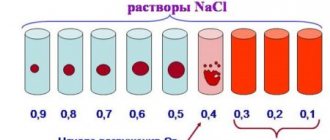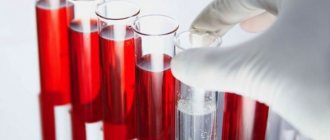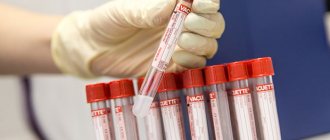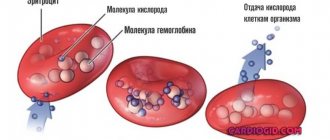Published: 03/30/2021 17:00:00 Updated: 03/30/2021
Erythrocytes are red blood cells, the most numerous blood cells. Formally, they are not cells, since during the process of maturation they lose many of the structures necessary for cells. For example, they lack nuclei and do not synthesize any protein molecules, unlike other cells in the body. So the name “cell” in this case is used for convenience. Red blood cells are formed in the bone marrow and constantly circulate in the body, performing the most important function of maintaining life - they carry oxygen from the lungs to tissues and organs and remove carbon dioxide.
In addition to red blood cells, blood contains plasma, platelets, and leukocytes. However, the number of red blood cells is so large that just a couple of drops of blood contains about one billion of these cells. They make up about 40% of the total blood volume. Actually, it is red blood cells that give our blood its characteristic red color due to its hemoglobin content.
Red blood cells do not last forever, they wear out over time and eventually die. The average life cycle of a red blood cell is approximately 120 days—a total of four months. However, do not worry, the bone marrow is constantly producing new cells and maintaining the required level of red blood cells. Various unfavorable circumstances can reduce or, conversely, increase their reproduction rate and affect their life expectancy - thus, the balance of blood composition is disrupted. An increase or decrease in red blood cells is associated with various pathological conditions. Let's consider this issue in more detail.
Red blood cells are normal
The normal limits vary depending on gender, age and other characteristics.
So, for an adult man it ranges from 4.0 to 5.1 × 10¹² units per liter of blood, and for women - 3.7 to 4.7 × 10¹² per liter.
In pregnant women, red blood cells may decrease to 3–3.5 x 10¹² per liter.
In children under one year of age, the concentration of red blood cells is constantly changing, so to assess the composition of their blood there is a special table that doctors use when interpreting tests.
In childhood, after one year there are still slight deviations from the “adult” norm, but by adolescence the level of red blood cells levels out.
RBC - what is it?
RBC (read as “ar-bi-si” or “er-be-tse”) is an abbreviation that comes from the English language and means “ Red blood cells ”, that is, “Red blood cells”. Simply put, red blood cells (although it is not entirely correct to call them cells, because they do not have a nucleus).
Red blood cells – the absolute number of red blood cells in the blood, expressed in units per liter.
This number is calculated by a specialist who examines the blood under a microscope. A small amount of blood enters a microslide, which is then viewed by laboratory staff through a special mesh. Having counted the number of red blood cells in each square of the grid, the laboratory technician multiplies them by the volume of blood and obtains the corresponding value.
Expert opinion
Kovaleva Elena Anatolyevna
Doctor-Laboratory Assistant. 14 years of experience in clinical diagnostic services.
Ask a question to an expert
Red blood cells can show pathologies in the hematopoietic organs, in which the number of red blood cells increases sharply (for example, in some forms of bone marrow cancer), the consequences of blood loss or death of red blood cells (reduced number of RBC), this indicator varies in people of different ages and gender.
Together with other indicators such as WBC (white blood cells) , RBC helps diagnose damage to the spleen, liver and other organs.
Elevated red blood cells
Red blood cells can be elevated due to many reasons, ranging from banal dehydration to erythremia - chronic leukemia.
Therefore, if there are any deviations in test results, you should consult a specialist to determine the cause. An increase in the number of red blood cells is called erythrocytosis, which can be: 1. Primary. A rare hereditary disease characterized by loss of energy, dizziness and darker color of the mucous membranes. 2. Secondary. Caused by other diseases or conditions (for example, smoking or staying in high mountains) and is associated with oxygen starvation of cells.
Thus, the following reasons for the increase in red blood cells can be identified:
- Dehydration. When the volume of fluid in the body is reduced, the percentage of red blood cells (and other blood cells) artificially increases.
- A lack of oxygen, which the body tries to compensate by producing more red blood cells.
- Congenital heart defect. If the heart cannot pump blood effectively, the amount of oxygen reaching the tissues is reduced. The body creates more red blood cells to compensate for oxygen deprivation.
- Genetic causes (changes in sensitivity to oxygen, impaired release of oxygen by hemoglobin).
- Polycythemia vera is a rare disease in which the body produces too many red blood cells.
Increased production of red blood cells can cause blood to thicken, slow blood flow, and related problems (eg, headaches, dizziness, vision problems, excessive blood clotting).
Often, elevated red blood cell levels are due to dehydration, hot weather, extreme stress, or excessive exercise. A pathological increase in red blood cells is a fairly rare pathology. Much more often, patients encounter reduced levels.
RBC indicator in men
In men, RBC varies more significantly than in women (see table). This is due to a man’s adaptation to heavy physical work and other activities that require exertion.
In particular, the number of RBCs increases in people involved in strength sports.
Red blood cells also increase in smokers .
A decrease in red blood cells is usually caused by a lack of animal protein in the diet, sources of which are meat and fish. Since men have more muscle mass than women, their protein needs are also higher.
Decreased red blood cells
The main symptoms of low red blood cell count are:
- Weakness or fatigue.
- Lack of energy.
- Paleness of the skin.
Reduced red blood cells are a relatively common pathology.
A low number of red blood cells and/or hemoglobin is called anemia. If there are few red blood cells, there is correspondingly less hemoglobin in the bloodstream, which carries oxygen. Thus, the body experiences oxygen starvation, and we feel weakness, drowsiness, loss of vitality, and dizziness. Due to anemia, hair falls out, the skin becomes pale and dry. There are many forms of anemia, each with its own cause. Anemia can be temporary or acquired; depending on severity - from mild to severe. According to a 2015 publication in The Lancet, about one-third of the world's population is anemic.
The most common causes of low red blood cells are:
- Unbalanced diet with deficiency of iron, vitamin B12 or folic acid.
- Damage to the bone marrow (toxins, radiation or chemotherapy, infection, certain medications).
- Any bone marrow disease.
- Chronic inflammatory processes.
- Bleeding in the digestive tract (for example, from ulcers, polyps, colon cancer).
- Heavy menstrual bleeding.
- Trauma with massive blood loss.
- Conditions that cause the destruction of red blood cells (for example, hemolytic anemia caused by autoimmune processes or defects in the red blood cells themselves).
- Kidney failure – serious kidney pathologies lead to a decrease in erythropoietin (or hematopoietin), a kidney hormone that promotes the production of red blood cells.
The risk of anemia is higher in the following groups:
- children aged from 6 months to 2 years;
- pregnant or recently given birth women;
- following a diet low in vitamins, minerals and iron, red meat;
- patients who regularly take medications that cause inflammation of the gastric mucosa (for example, ibuprofen);
- having a family history of hereditary anemia such as sickle cell anemia or thalassemia;
- patients with an intestinal disorder that affects the absorption of nutrients (eg, Crohn's disease);
- have recently experienced major blood loss due to surgery or injury;
- people with chronic diseases (HIV, diabetes, kidney disease, cancer, rheumatoid arthritis, heart failure, liver disease).
Decoding the analysis result
Both an increase and a decrease in the number of red blood cells can be a sign of disease. Let's consider common and dangerous diseases that are associated with fluctuations in the number of RBCs:
Promotion
- The most dangerous cause of an increase in the number of red blood cells is bone marrow cancer . Normally, the bone marrow constantly produces new red blood cells. This occurs through the constant division of specialized cells, one of which evolves into a red blood cell, and the second remains for subsequent divisions. But with cancer in the bone marrow, division gets out of control, cells divide en masse and much faster than normal. That is why red blood cells begin to be released in huge quantities.
- The second cause may be kidney disease. The fact is that some kidney pathologies are associated with an increase in erythropoietin , a hormone that promotes hematopoiesis.
- Less common are pathologies associated with a lack of oxygen. The reason for this may be a lack of hemoglobin in each individual red blood cell, which the body compensates for by increasing the number of red blood cells themselves.
Demotion
In some diseases, the number of red blood cells dramatically decreases. Firstly, this may be associated with the same oncology of the red bone marrow, because not all forms of cancer cause uncontrolled production of blood cells, some act in exactly the opposite way.
Infectious diseases can also affect red blood cells . This happens with malaria, which can be contracted in southern countries.
Red blood cells can decrease due to poor nutrition (vegetarianism in childhood and adolescence, lack of vitamins, excess dairy foods), infection with parasitic worms , and so on.
Deviation from the norm is not always a disease
If the level of red blood cells during the first analysis is slightly outside the normal range, do not panic.
Your doctor will help you interpret the results correctly, taking into account your individual characteristics and medical history. A single slightly elevated or slightly decreased result may have no medical significance. There are several factors that can cause a test result to fall outside the established reference range without pathological reasons:
- Under the influence of external factors (stress, previous infections, physical activity), the results of the analysis of the same person may differ slightly. In this case, a person can be healthy. If the analysis shows a slight deviation, retake the test on another day.
- Individual characteristics. For some people, the boundaries of the norm may differ slightly from generally accepted ones. Reference values are valid for the vast majority of people, but we are all different, and in some rare cases, a healthy person may have their own norms, slightly different from the usual values.
Only a doctor can accurately determine this after conducting additional research.
Study of the level of red blood cells and leukocytes
In WBC and RBC blood tests, indicators reflect the state of leukocyte and erythrocyte cells. As already noted, overestimated and underestimated norms of both red blood cells and leukocytes may appear, which indicate a number of diseases.
For example, leukocytes are increased in inflammatory purulent processes, myocardial infarction, stroke, extensive burns, uremia, hemolysis, carbon monoxide poisoning and many other diseases. And they are underestimated for influenza, viral hepatitis, human immunodeficiency virus, measles, rubella, bacterial and protozoal infections, and autoimmune diseases.
When analyzing WBC and RBC blood, the values may simultaneously be underestimated in case of hypersplenism syndrome (that is, with an enlarged spleen). In addition, there is a decrease in the number of platelets. The level of erythrocytes and leukocytes can be determined through general and detailed blood diagnostics.
Tests for red blood cells
A red blood cell count and cell count is usually done as part of a complete blood count (CBC).
A general blood test is the most common analysis, informative for almost any pathological process. This test can also be used to diagnose and/or monitor a number of diseases that affect the production or lifespan of red blood cells. You can take a general blood test with determination of 5 fractions of leukocytes at any CityLab medical center.
For an accurate diagnosis, the doctor may prescribe additional tests:
- Reticulocyte count - determines the number of immature red blood cells.
- Iron test - this trace element plays an important role in the production of red blood cells.
- Vitamin B12 and folic acid levels – these vitamins are also important for red blood cell production.
- A blood test for ferritin reflects iron reserves in the body.
- Serum iron, total iron-binding capacity of blood serum are additional parameters reflecting the process of iron metabolism in the body.
Author:
Baktyshev Alexey Ilyich, General Practitioner (family doctor), Ultrasound Doctor, Chief Physician
Level of indicator in children
In children, a common cause of low red blood cells is poor nutrition. A lack of vitamins, proteins, and iron can seriously affect the hematopoietic system, which will lead to a decrease in the production of red cells.
A child’s body is much more sensitive to the lack of certain substances in food, and besides, children are often overly picky about food. Therefore, with a reduced RBC level, the first task of parents is to ensure that the child begins to eat normally. You should definitely eat meat, apples, pomegranates or pomegranate juice. You can buy hematogen at the pharmacy.
Description of the causes of erythrocytosis
An excess of red blood cells in the blood plasma is called erythrocytosis. As a result, the blood begins to thicken and moves through the capillaries with difficulty. Red blood cell production spontaneously increases in the body when oxygen levels in cells decrease. Lack of oxygen can be caused by congenital pathology of the heart muscle, heart failure, hemoglobinopathy, chronic obstructive pulmonary disease, and excessive smoking.
It is possible to regulate the formation of red blood cells with the help of certain drugs. These include anabolic steroids, erythropoietin protein and some groups of antibiotics intended for the treatment of infectious and inflammatory processes in hematopoiesis.
The consequence of an increase in red blood cells in blood cells can be dehydration, which occurs as a result of an increase in temperature in the body, the occurrence of gag reflexes and loose stools. During such deviations, the concentration of red blood cells increases, but their number does not change.
The value of normal hematocrit in humans
The body of a healthy adult contains approximately 4.5-5 liters of blood. It contains formed elements and cells - red blood cells, platelets, leukocytes, as well as a liquid part called plasma.
Some blood components, for example, red blood cells, do not have all the necessary components of a human cell, losing them during the maturation process. Therefore, red blood cells and platelets are called blood cells, not cells.
In different categories of patients, the normal values of various parameters of the blood tested will differ. So, for most men, the hematocrit will be higher: 40-41%, and in some cases it can reach up to 51%, which is due to its slower renewal.
In healthy women, the hematocrit usually ranges from 36 to 42%. This is due to physiological features - due to regular menstrual bleeding, blood is renewed more often to replenish its volume. During pregnancy, from the 20th week, the indicator begins to decrease, which is also not considered a deviation.
In children, hematocrit differs at different age periods:
- 44-62% for newborns;
- 32-43% for babies up to three months;
- 36-43% for children under one year of age;
- 35-47% (up to 52% for boys) - in the first ten years.
In subsequent years, the hematocrit norm depends on gender and practically corresponds to the values of an adult.









